How To Remove Calcium Buildup On Night Guards
30th May 2025
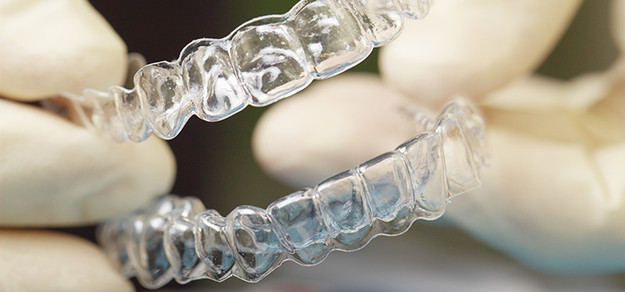
Wondering how to remove calcium buildup on night guards? Calcium buildup, caused by minerals in saliva, often appears as white, chalky spots. If not cleaned, it can lead to odors and reduce your night guard’s effectiveness.
This guide will show you simple steps to safely remove the buildup, explain why it happens, and share tips to keep your night guard clean. Let’s get started!
What Does Calcium Buildup on Mouth Guards Look Like?

If you don’t know what calcium buildup on your mouth guard looks like, you may not even realize that it’s starting to develop. Typically, calcium deposits appear as hard, crusty white spots on your night guard.
Occasionally, calcium buildup might also appear as yellow stains. This can happen on all dental appliances, such as mouthguards, night guards, retainers, and clear aligners.
Note: The buildup may begin as a small spot, and it will likely grow over time if you’re not regularly cleaning your night guard. This is why it’s important to keep a close eye on the condition of your night guard.
Why Does Calcium Accumulate on Mouthguards?
Plastic mouthguards, especially those made from ethylene vinyl acetate (EVA), have tiny pores and charged surfaces that attract bacteria, proteins, and fungi. This creates biofilms, which can trap minerals from saliva and form chalky or crusty buildup that looks like calcium.
A study found that harmful microbes like Candida albicans and Bacillus cereus can live in these surfaces, potentially producing toxins and affecting your health if the mouthguard isn't cleaned regularly.
Our mouths are full of many kinds of bacteria, so bacterial growth on a mouthguard is both common and normal. In fact, there are over 6 billion bacteria in our mouths at any given time (How et al 2016). Of these bacteria, some are necessary and healthy, while others are harmful.
Johnson & Johnson explains, “certain healthy bacteria work to protect your mouth (some, for example, specifically help limit tooth decay). There's also harmful bacteria that are known to cause cavities and disease”. When bacteria combine with tartar, plaque buildup, and saliva, calcium spots can form. This is a normal and natural process, and it doesn’t mean your mouth is dirty.
Related Articles:
- How to Clean Your Night Guard
- Night Guard Turning Yellow
- Night Guard Has a Bad Taste? Here’s What To Do
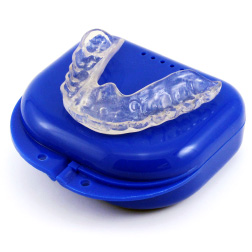
- Most Popular
- Hard Outside, Soft Inside
- 2MM Thick
- Moderate / Heavy
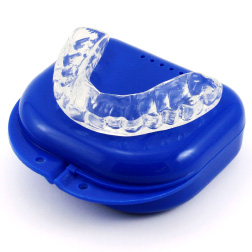
- Most Durable
- Hard Materials
- 1.5MM Thick
- Heavy / Severe
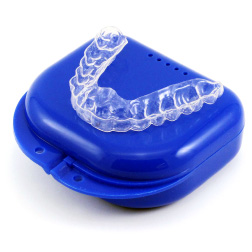
- For Day Time Use
- Thin, Barely Visible
- 1MM Thick
- Light / Moderate
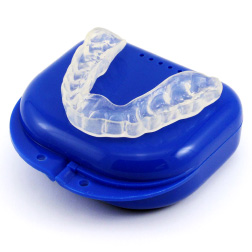
- For Clenching
- Flexible & Soft
- 1.5MM Thick
- Light / Moderate
What Causes Calcium Buildup on Night Guards?
Calcium buildup, also known as tartar, happens when minerals in your saliva stick to your night guard and harden over time. Saliva contains natural minerals like calcium and phosphate, which are essential for keeping your teeth healthy. However, when these minerals settle on your night guard, they can create white, chalky spots that are tough to remove.
Some common reasons for calcium buildup include:
Inconsistent Cleaning: Skipping daily cleaning allows minerals and bacteria to accumulate.
Improper Storage: Storing your night guard in a damp or unventilated case encourages buildup.
Hard Water Rinsing: Using hard water, which is high in minerals, can leave deposits on your night guard.
How to Remove Calcium Buildup on Night Guards
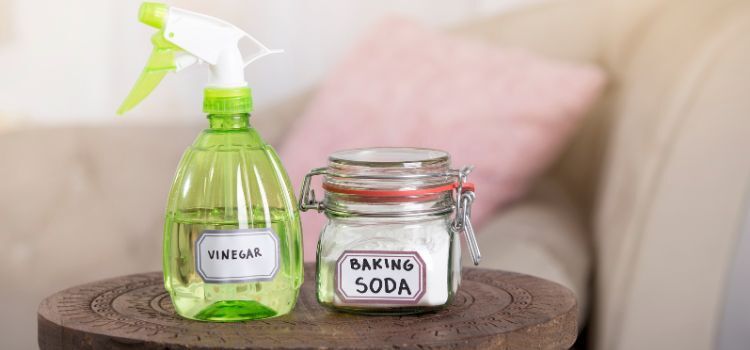
Cleaning calcium buildup from your night guard is easier than you might think. Follow these simple steps to safely remove the buildup without damaging your night guard:
Step-by-Step Cleaning Guide
Prepare a Vinegar Solution:
Prepare a vinegar solution by mixing equal parts white vinegar and warm water in a bowl or container. Soak your night guard in this solution for 15 to 30 minutes to help loosen any buildup.
Gently Brush the Surface:
Use a soft-bristled toothbrush to gently scrub the night guard, focusing on areas with visible buildup. Avoid using abrasive toothpaste, as it can damage the material.
Rinse Thoroughly:
Rinse the night guard under warm running water to remove any vinegar residue.
Optional Deep Clean:
For a deeper clean, use denture cleaning tablets or an ultrasonic cleaner following the manufacturer’s instructions.
Air Dry Completely:
Place the night guard on a clean, dry surface and allow it to air dry completely before storing it.
What to Avoid
- Harsh Chemicals: Bleach, alcohol, or strong household cleaners can damage the material.
- Abrasive Tools: Avoid hard brushes or abrasive cleaning agents, which can scratch the surface.
By following these steps, your night guard will be free of calcium buildup and ready to use.
How to Avoid Calcium Buildup
It’s much easier to avoid calcium buildup in the first place than it is to remove buildup after it has already happened. To avoid calcium buildup, clean your night guard after each use and deep clean it regularly.
Typically, it is recommended that you give your night guard a deep clean once a week. A clean night guard is an effective night guard. Try any of the following methods to clean your night guard:
- Brush your night guard with a soft-bristled toothbrush and non-abrasive toothpaste
- Clean your night guard with denture cleaner (cleaning tablets) or mouthwash (but avoid mouthwash that contains alcohol)
- Soak your night guard in white vinegar or hydrogen peroxide
- Brush a paste of water and baking soda onto your night guard
- Clean your night guard with household dish soap (make sure it is antibacterial soap)
Bleach is not a recommended cleaning method because it is a harmful chemical that can actually damage the guard.
Regardless of the cleaning method you use for your night guard, thoroughly rinse it off after you’re done cleaning.
When you rinse, use warm or cool water; hot water can ruin the fit of a custom night guard. Then, either dry your night guard with a soft towel or allow it to air dry before putting it back in its case. Letting a wet night guard sit in a case can contribute to mold growth.
While it’s difficult to remove calcium buildup, proper cleaning can ensure the deposits don’t get larger. Many people find the most effective method to remove buildup is to soak your night guard in vinegar then scrub your night guard with a soft-bristled toothbrush. Your dentist may also be able to help you remove the buildup on your night guard.
Baking Soda Helps Remove Calcium Buildup
Baking soda is a versatile cleaner due to its alkalinity, mild abrasiveness, and deodorizing properties. It can tackle a wide range of cleaning tasks.
While its direct effectiveness on stubborn calcium stains is limited, it becomes a much more powerful cleaning solution for limescale when combined with an acid like vinegar. The acid helps to dissolve the mineral deposits, and the baking soda provides the scrubbing power to remove them.
A study that focuses on tooth surfaces, suggests that using baking soda with an electric toothbrush could enhance cleaning efficacy. This combination might be beneficial for removing surface stains or deposits on dental appliances like night guards.
Why Removing Calcium Buildup Is Important
Keeping your night guard clean isn’t just about appearance—it’s essential for your oral health and the lifespan of the device. Here’s why removing calcium buildup matters:
- Prevents Odors: Buildup can trap bacteria, leading to unpleasant smells.
- Maintains Effectiveness: A clean night guard fits better and protects your teeth more effectively.
- Avoids Damage: Hardened calcium deposits can make the material brittle over time.
- Improves Hygiene: Regular cleaning reduces bacteria and plaque, protecting your teeth and gums.
By removing calcium buildup, you ensure your night guard stays fresh, comfortable, and effective for years to come.
When Is It Time to Replace Your Guard?
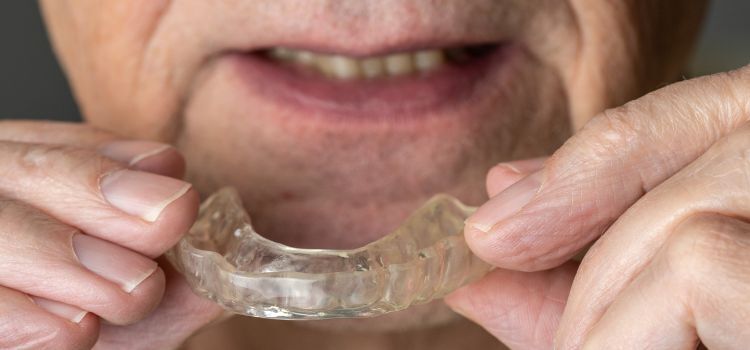
Calcium buildup alone is not an urgent indication that you need to replace your night guard, but it can be a sign that you may need a replacement soon. A typical mouthguard lifespan depends on 3 factors:
- which type of night guard you have
- how severely you grind your teeth
- how well you take care of your night guard.
In general, you shouldn’t have a night guard for more than four years.
If you start to notice that the discoloration on your night guard progresses to black spots that you cannot remove, it’s definitely time to replace your guard.
This is an indication of mold. Another reason to replace your night guard is if you notice that it is causing you to have bad breath. This is an indication that bacteria buildup is progressing.
In some cases, calcium buildup can progress to affect the stability of your night guard. When this happens, it’s definitely time to get a new one.
You might notice that your night guard doesn’t fit the way it used to or that there are raised bumps in the locations of the calcium deposits. When calcium buildup starts to affect the stability of the guard, it compromises the device so that it no longer can protect your teeth and jaw effectively.
Related Articles:
Conclusion
Calcium buildup on night guards is a common issue, but it’s easy to manage with the right care routine. By cleaning your night guard regularly and using proper storage techniques, you can prevent buildup, eliminate odors, and ensure it stays effective for years to come.
Remember, regular maintenance is key to keeping your night guard fresh and hygienic. Whether you’re removing buildup or taking steps to prevent it, these simple tips will help you protect your night guard and your oral health. A clean night guard means a healthier, more comfortable smile!
Need a new night guard or want to upgrade to one that’s easier to maintain? Explore Pro Teeth Guard’s custom-fit night guards for a durable, hygienic solution tailored to your needs. Contact us with any questions—we’re here to help!
References:
- Bullard, J. W. (2004). Ecology and epidemiology of athletic protective mouth guards (Master’s thesis, Oklahoma State University). Oklahoma State University Center for Health Sciences. https://hdl.handle.net/11244/123456
- How, K. Y., Song, K. P., & Chan, K. G. (2016). Porphyromonas gingivalis: An Overview of Periodontopathic Pathogen below the Gum Line. Frontiers in microbiology, 7, 53. https://doi.org/10.3389/fmicb.2016.00053
- Segrest, S. (2021). 4 fascinating things scientists know about the billions of bacteria in your mouth. Johnson & Johnson. https://www.jnj.com/innovation/4-things-scientists-know-about-the-bacteria-in-your-mouth
- Haruyama, A., Kojima, M., Kameyama, A., & Muramatsu, T. (2022). Combined use of baking soda and electric toothbrushing for removal of artificial extrinsic stain on enamel surface: An in vitro study. Journal of Clinical and Experimental Dentistry, 14(1), e9–e15. https://doi.org/10.4317/jced.58708

- Most Popular
- Hard Outside, Soft Inside
- 2MM Thick
- Moderate / Heavy

- Most Durable
- Hard Materials
- 1.5MM Thick
- Heavy / Severe

- For Day Time Use
- Thin, Barely Visible
- 1MM Thick
- Light / Moderate

- For Clenching
- Flexible & Soft
- 1.5MM Thick
- Light / Moderate
